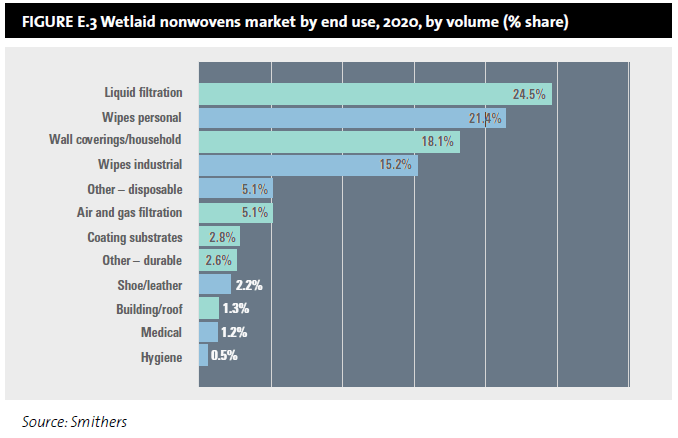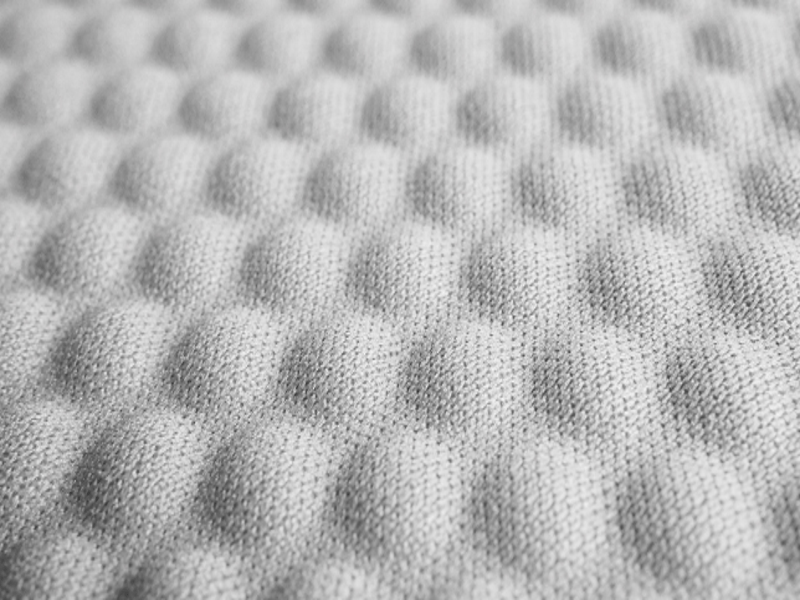Analysis in the new dedicated study
The Future of Wetlaid Nonwovens to 2025 shows future growth will drive this market past the $2 billion mark by 2025. It will be the second fastest growing nonwovens technology behind spunlaid and represents a key focus for the industry.

As the wetlaid market expands, sustainability will become an increasingly important consideration for key end-use products such as personal and industrial wipes, wall coverings and filtration media.
This is being driven both by consumer expectations impacting the decision making of major brand owners, and is supported by legislation aimed to minimise the impact of single-use plastics and nonwoven wipes on the environment.
How green are wetlaids?
Wetlaid nonwovens are one of only two nonwoven processes – along with airlaid – that can boast inherent sustainability.
Their strong environmental credentials are due to the high level of cellulosic raw materials they use. This is mainly wood pulp, but also rayon and lyocell, and significant volumes of other natural fibres, such as abaca and hemp. This raw material base provides sustainability, low cost, char-forming flame-retardancy, and hydrophilicity.
Overall around 70% of wetlaid nonwovens are definitely biodegradable. The remaining 30% includes about 10% binders, which varying levels of biodegradability. As companies in multiple industries, including automotive and hygiene, look to deliver on new green corporate citizenship commitments wetlaid nonwovens have multiple opportunities to replace polymer-based materials.
As this happens however there is a threat from a new generation of lighter weight and lower cost spunlaid formulations. Recent developments in spunlaid cellulose, such as Asahi Kasei’s Bemliase and Lenzing’s LenzingWeb, match or surpass wetlaid in some key criteria. Furthermore the ongoing development of polyhydroxyalkanoates (PHA), polylactic acid (PLA) and other biopolymers presents a route to a genuinely compostable spunlaid nonwoven.
Single-use plastics
Passed in June 2019, the EU’s Single-use Plastics 2019/904 has become a key plank of Europe’s drive towards a circular economy. Aimed mainly at minimising plastic waste, wipes and feminine hygiene sanitary items are the nonwovens products affected most.
While no outright ban of wipes is suggested, there are requirements for:
- Improved labelling on disposal
- Compulsory participation in consumer awareness campaigns
- Funding clean up measures via an extended producer responsibility (EPR) program.
Although enforcement is unlikely any earlier than 2022 for nonwovens, producers are already scrambling to develop products with no plastic. Many will switch over to ‘plastics-free’ wipes as soon as feasible to be prepared in advance of ‘mandatory’ requirements, and to promote themselves as ethical suppliers or retailers.
This brand owner led trend is underway already, with some companies moving to 100% cotton wipes despite the cost premium this creates.
A further difficulty is that the directive’s definition of plastic – ultimately derived for the EU REACH Regulation 1907/2006 – is any material that is chemically modified in its production. This means almost all binders currently in use are defined as ‘plastic’ – including viscose and lyocell despite both being biodegradable and made from renewably sourced fibres.
Wetlaid already has one process variant with no plastic content, hydroentangled wetlaid using pulp/lyocell or pulp/viscose blends. Although strength issues make this a focused rather than a broad spectrum solution, Smithers forecasts continued research on this variant.
Airlaid nonwovens with a ‘non-plastic’ binder would be another option for several products.
Flushable wipes
A longer standing issue for personal wipes is flushability, and especially the potential of these to cause blockages in sewers.
Nonwoven trade associations – principally the US Association of the Nonwoven Fabrics Industry (INDA) and the European Disposables and Nonwovens Association (EDANA) – have done an excellent job of pre-empting direct regulation by developing the first scientific tests and methodology for identifying flushable wipes that will not harm the wastewater system.
Flushability will remain an issue moving forwards generating new demand for hydroentangled wetlaids in particular. This process variant presents that most likely avenue to fully resolving concerns over flushability in the next 10 years.
Vehicle fuel filters
Fuel filtration is an important market for wetlaid nonwovens. Producers in this area will benefit from tighter regulations on emissions from diesel-powered vehicles as stricter standards require engines that employ high-pressure common rail (HPCR) fuel injection systems.
Without HPCR diesel engines will find it very difficult to gain regulatory approval. There is a need for more and better nonwovens for fuel filtration to allow the efficient use of HPCR and to eliminate particulate emissions. Older paper and wetlaid nonwovens are thus forecast to be replaced by a new generation of superior filtration media.

